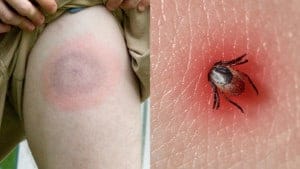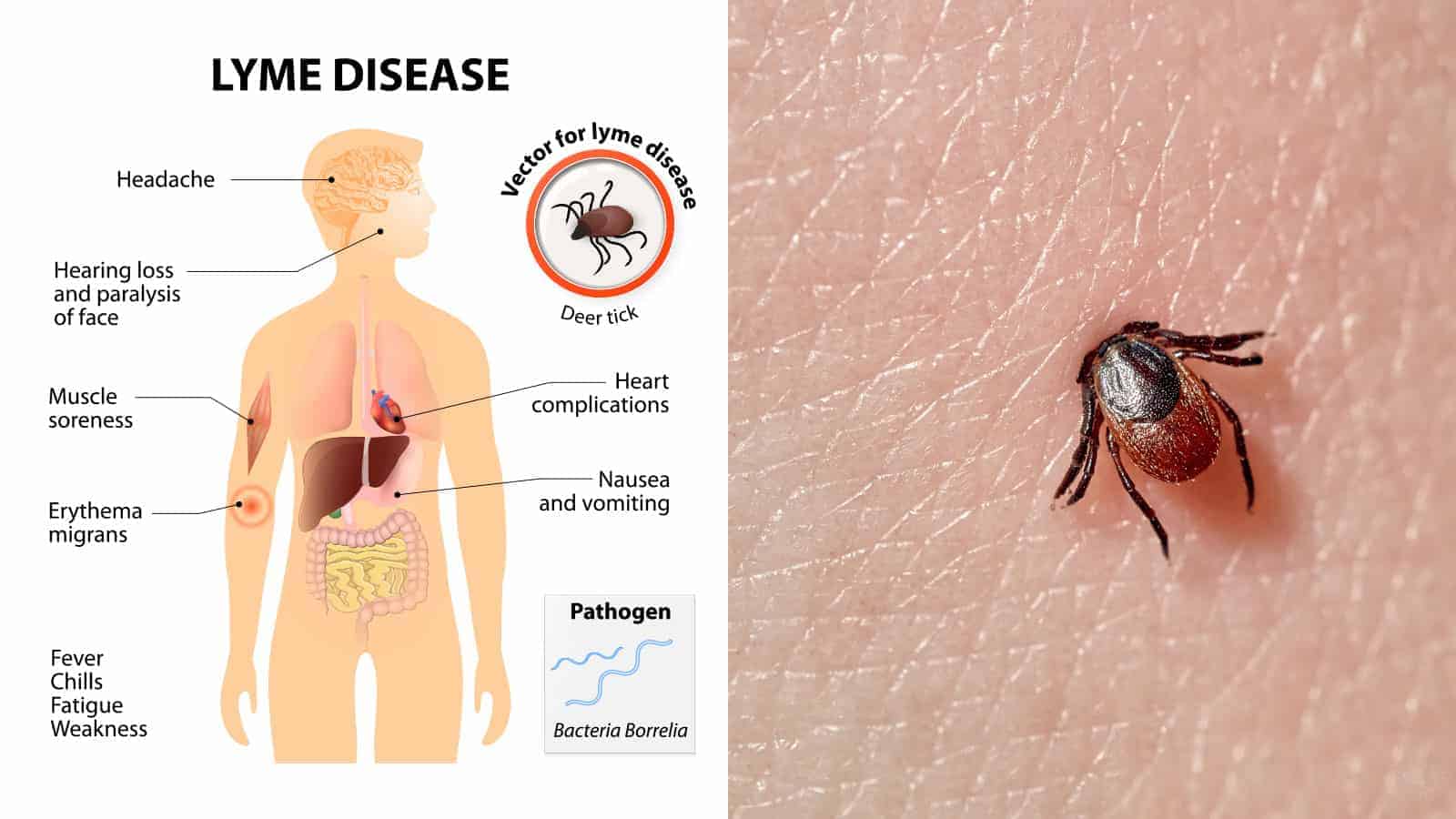Lyme disease is a condition caused by bacteria carried by the black-legged, or deer tick. The disease is transferred to humans when deer ticks burrow into and bite human flesh. You are at risk for contracting Lyme disease if you live in or frequent heavily wooded areas where Lyme-carrying ticks thrive. If you are at risk of contracting the disease, it is essential that you take precautions to prevent the onset of its serious symptoms and potentially dire consequences.
Cause of Lyme disease
To contract Lyme disease, a tick that is infected with the Borrelia burgdorferi or the borrelia mayorii bacteria must bite you. While mature ticks are fairly easy to spot, the young ones are light brown in color and may be nearly impossible to detect. These bacteria enter your bloodstream through the bite on your skin and eventually create more serious symptoms if not detected.
Risk factors for the development of Lyme disease
Where you live or vacation has an effect on whether you contract Lyme disease. Your profession and extracurricular outdoor activities also play a role in your risk factor for its development. The most common risk factors for its development are:
- Spending time outdoors in wooded or grassy areas
- Having exposed skin when working or playing outdoors
- Failing to remove ticks promptly or properly
Many people don’t initially realize that they’ve been infected by a deer tick, and it may be weeks or months before they begin to realize that the signs and symptoms they are experiencing are in fact Lyme disease. Early detection is key to effective treatment; if left unchecked, the complications and consequences of this disease could be severe. Knowing what to look for is essential for proper diagnosis and treatment.
Early signs and symptoms
A small red bump usually resembling a mosquito bite occurs at the site of the tick bite, but this is not necessarily an indicator that disease and infection are present. Within a few weeks to a month, however, the following symptoms may occur that point to infection:
1 – Rash
Anywhere from three days to a month after the discovery and removal of a tick, a red, bullseye-like rash may spread over the original site of the bite. The rash typically spreads in a circular pattern, and it can sometimes cover areas of the body up to twelve inches in diameter. The rash is not painful or itchy, but it will be warm to the touch.
2 – Fever
Shortly after the rash has begun to develop, it is not uncommon for someone to develop a high fever suddenly and in the absence of other symptoms. This fever can be consistent, or it can come and go intermittently, confusing both patient and doctor as attempts for diagnosis are made.
3 – Chills
Chills are likely to develop shortly after fever sets in, as this is the body’s natural response to trying to cool the body down. Chills that are uncontrollable and constant are sure signs that the body is trying desperately to fight off infection. Don’t ignore this warning signal–see your doctor immediately to begin treatment.
4 – Body aches and neck stiffness
Body aches and neck stiffness, in particular, are signs that infection has set in. Neck stiffness is an indicator that bacteria are working themselves along your spinal column and will eventually affect brain health and development.
5 – Swollen lymph nodes
Your body’s lymph nodes are the drainage system; they work to reduce and eliminate toxins throughout your body while increasing the circulation of more positive and proactive elements that promote good health. Swollen lymph nodes are a sign that something is stopping the process of toxin elimination, and this can get ugly pretty quickly if the cause of the swelling is not identified and stopped.
Looking for these symptoms and being able to put together pieces of the puzzle are keys to early detection and treatment.
Later signs and symptoms of Lyme Disease
It is not uncommon for people to have no idea that they have been infected with this disease for years, as they deem their symptoms nonspecific. Looking for these later-stage symptoms in combination with classic early signs will help you to effectively detect it:
1 – Erythema migrant
The persistent red, warm rash may spread to other areas of the body, indicating inflammation is present.
2 – Severe, migrating joint pain
Severe, stabbing joint pain can persist for days or weeks at a time. Most common in shoulders and knees, it is enough to reduce mobility and cause the sufferer to experience a reduced quality of life as a result of migrating, severe joint pain.
3 – Neurological problems
A culminating occurrence of this condition is an inflammation of the lining around the brain, known as meningitis. You may also experience temporary facial paralysis, reduced mobility in your limbs, and muscle cramping, all of which make moving and maintaining a regular level of activity very difficult.
Less frequent symptoms
Although rare, some people experience the following symptoms in connection with the disease:
- Heart palpitations
- Eye inflammation
- Liver inflammation and failure
- Extreme and persistent fatigue
Each of these symptoms in and of itself is alarming. But in combination with one another, one should cause one to seek medical attention immediately to discover the underlying cause and undergo treatment.
When should I see a doctor?
If you have discovered a bite from a tick and you have been exhibiting some of the above symptoms after the tick was discovered and removed, see your doctor for a proper diagnosis. In most cases, if a tick is removed within 36 hours of contact, the risk for contracting the disease is unlikely.
If you suspect that you have been bitten, however, or you are showing symptoms of infection and you live in an area where people are prone to picking up ticks on skin or clothing, err on the side of caution and see your doctor. Even if signs and symptoms disappear, it is a good idea to undergo proper blood testing to rule out possible disease or infection.
If Lyme disease is allowed to go unchecked, it can spread to other areas of the body and lie dormant for a time, then begin to effect profound issues with muscles, nerves, and even neurological activity in your brain.
Preventing Lyme Disease
The best way to prevent any tick-borne diseases is to avoid heavily wooded areas with tall grass where deer ticks live. The Center for Disease Control and Prevention (CDC) in Atlanta, Georgia recommends you take the following measures against the development and spread of the disease:
1 – Cover your skin.
When you find yourself in heavily wooded or tall grassy areas, wear closed shoes, long pants tucked into socks, and long sleeve shirts. Hats and gloves are also recommended for long periods of time spent out in these areas. Stick to trails rather than going off the beaten path, and when you return home, promptly shed this outdoor clothing in favor of something that hasn’t made the trip with you. Thoroughly inspect your skin and affected clothing before resuming daily activities.
2 -Use insect repellent.
Many insect repellents are formulated nowadays to include chemicals that deter deer ticks as well; look for blends with concentrations of DEET at 20 percent or higher. If children are accompanying you outdoors, thoroughly clothe and prep them as well before going out.
3 – Tick-proof your yard.
Clear away brush and leaves where ticks can thrive. Cut grass short, and maintain it regularly. Stack any firewood in sunny areas to deter rodents that might carry ticks from setting up residence there. Staying diligent with inspection after being outdoors is key to the prevention of any tick bites and the development of diseases that they carry.
 4 – Shower after searching.
4 – Shower after searching.
Remaining diligent about checking for ticks after being outside is important; you can take prevention one step further by showering or bathing after an outing outdoors. You’ll rinse away unattached insects that go unnoticed with soap and washcloth. You’re none the wiser but tick-free by treating yourself to some self-care.
5 – Don’t assume you’re immune if you have had it before.
You can contract Lyme disease again, and there are chances that the second time around could have more severe consequences. Take proper precautions and remain diligent about self-inspection will keep you protected.
6 – Remove ticks as soon as possible with tweezers.
Gently grasp the tick by the head or the mouth. Being careful not to crush or squeeze it, pull firmly and steadily. Once removed, put it in rubbing alcohol or flush it down the toilet to dispose of it. Then, wipe the affected area with antiseptic to reduce the possibility of infection.
 Final Thoughts on Avoiding Lyme Disease
Final Thoughts on Avoiding Lyme Disease
You don’t have to be an expert on deer tick activity to prevent the onset of this disease. However, early detection of signs and prompt treatment will help you to enjoy outdoor time with your loved ones. Finally, you must be vigilant about the prevention and assessment techniques necessary to live infection free all season long.

















